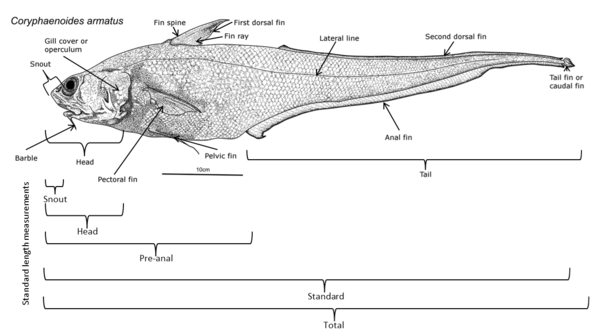Abyssal grenadier
The abyssal grenadier, Coryphaenoides armatus, is an abyssal fish of the genus Coryphaenoides, found in all the world's oceans, at depths between 800 and 4,000 m. Its adult length is 20 to 40 cm, although Fishbase[2] gives lengths up to 1 m. The abyssal grenadier's body is unique in that it contains two dorsal spines and about 124 dorsal soft rays, which are the flexible jointed rays supporting a fin nearest to the back in the spinal column. It has no anal spines, but has 115 anal soft rays along its body. The head and eyes of this fish are very large, while the mouth is very small. The color of the abyssal grenadier is brown apart from the abdomen, which is bluish.[3][4]
| Abyssal grenadier | |
|---|---|
 | |
| Abyssal grenadier, Coryphaenoides armatus | |
| Scientific classification | |
| Kingdom: | Animalia |
| Phylum: | Chordata |
| Class: | Actinopterygii |
| Order: | Gadiformes |
| Family: | Macrouridae |
| Subfamily: | Macrourinae |
| Genus: | Coryphaenoides |
| Species: | C. armatus |
| Binomial name | |
| Coryphaenoides armatus (Hector, 1875) | |
| Synonyms[2] | |
| |

Coryphaenoides armatus occurs at the deep-slope, on the upper continental rise between 2,000 m and 4,700 m. Its diet changes as it matures, from benthic invertebrates such as crustaceans and holothuroids when young to mesopelagic and bathypelagic fish, sea urchins and cephalopods when adult. Examination of the stomach contents of specimens collected by trawling below 2,600 m deep in the Hudson Canyon showed that an important proportion of the diet of C. armatus is caught in the deep mesopelagic and bathypelagic regions. Very few ripe females, and no spent individuals have been collected, and this is suggestive of this species being semelparous.[1]
See also
References
- Fernandes, P.; Cook, R.; Florin, A.-B.; Lorance, P.; Nielsen, J. & Nedreaas, K. (2015). "Coryphaenoides armatus". The IUCN Red List of Threatened Species. 2015: e.T18125776A60791529. doi:10.2305/IUCN.UK.2015-4.RLTS.T18125776A60791529.en.
- Froese, Rainer and Pauly, Daniel, eds. (2018). "Coryphaenoides armatus" in FishBase. February 2018 version.
- Cohen, D.M., T. Inada, T. Iwamoto and N. Scialabba. 1990.
- MICHAEL ALLABY. "spiny fin ray." A Dictionary of Zoology. 1999. Encyclopedia.com. 23 Jun. 2010 <http://www.encyclopedia.com>.
Further reading
- Tony Ayling & Geoffrey Cox, Collins Guide to the Sea Fishes of New Zealand, (William Collins Publishers Ltd, Auckland, New Zealand 1982) ISBN 0-00-216987-8
External links

